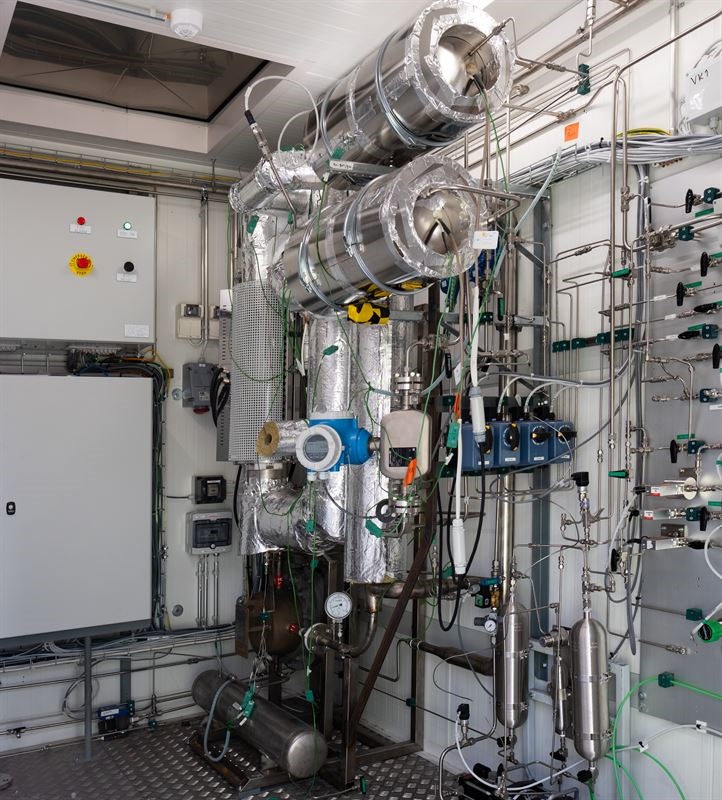NEWS
Research project discovers ways to convert forest industry’s carbon dioxide emissions into raw material for plastics
VTT Technical research centre of Finland and LUT University have completed a three-year research project on carbon capture and utilisation. The project investigated different technologies for producing renewable plastic raw materials from carbon dioxide and green hydrogen. Renewable energy, hydrogen economy and forest industry’s biogenic carbon dioxide emissions present significant opportunities for new sustainable industries.
The Forest CUMP research project of VTT and LUT University investigated how biogenic carbon dioxide from forest industry and waste incineration can be captured and converted into high-value-added products, such as polypropylene and polyethylene. They are raw materials for the most common types of plastics used in everyday life, and their production currently relies mainly on fossil raw materials.
“We investigated through pilot activities and modelling, how the biogenic carbon dioxide recovery chain can be adapted to existing petrochemical plants and the production of key basic plastics. For rapid and significant replacement of fossil feedstocks with renewable ones, technologies need to be adapted to the currently existing production facilities,” says Juha Lehtonen, Research Professor at VTT.
For example, the equipment used to separate hydrocarbons is an expensive long-term investment. Therefore, it makes sense to adapt renewable raw material processes to the currently available industrial equipment.
“Our research showed that the low-temperature Fischer-Tropsch process is a technically and economically promising alternative for the production of renewable polymers such as polyethylene and polypropylene. We can use Fischer-Tropsch naphtha directly in existing petrochemical processes as a feedstock for the above-mentioned plastics without major additional investments into current petrochemical units (e.g. distillation and separation processes or steam cracker). Producing the necessary hydrocarbons through alternative process routes such as methanol or the high-temperature Fischer-Tropsch process would require expensive investments in production facilities,” Lehtonen explains.
Finland's energy and hydrogen infrastructure are in good shape
Finland has significant biogenic carbon dioxide reserves that can be used to replace fossil-based carbon feedstocks. Finland's potential is based on large, relatively easily exploitable individual sources of bio-based carbon dioxide, such as forest industry production facilities. Thes types of renewable carbon dioxide sources are rarely found in Europe outside the Nordic countries.
“The capture of wood-based carbon dioxide offers a significant opportunity for Finland to build new industrial value chains while simultaneously reducing the use of fossil raw materials. The experimental work and piloting conducted within the Forest CUMP project provide valuable insights into the potential of carbon dioxide as a raw material for plastics,” says Kaija Pehu-Lehtonen, the project manager of Metsä Group’s carbon capture initiative.
In addition to a stable, large-scale, and year-round supply of bio-based carbon dioxide, Finland's energy and hydrogen infrastructure is well-positioned to support the growing use of renewable energy sources and hydrogen. As we move away from fossil hydrocarbon products, one of the main challenges will be securing an adequate supply of green hydrogen. Going forward, Finland's energy infrastructure provides good potential for large-scale green hydrogen production through water electrolysis using renewable energy.
According to research by VTT, converting 10 million tons (Mt) of biogenic carbon dioxide into renewable products would require approximately 60 TWh of renewable electricity (while Finland’s annual electricity consumption is around 85 TWh). For example, processing 10 Mt of carbon dioxide and 1 Mt of hydrogen would yield approximately 3 Mt of diesel fuel, equivalent to Finland’s total annual consumption. Finland has about 30 Mt/a of large bio-based CO2 sources (over 0.1 Mt/a each), meaning the country already has the necessary raw materials and infrastructure for industrial-scale production. Instead of focusing on fuels, the Forest CUMP project explored the possibility of capturing bio-based carbon dioxide in long-lasting polymer products.
The business ecosystem covers the chain from factory chimneys to plastic products
The Forest CUMP project brought together business partners and researchers to tackle major future challenges. Borealis, a provider of advanced and sustainable polyolefin solutions, is one of the companies participating in the project. Forest CUMP is part of Borealis' SPIRIT programme, which promotes the green transition of the plastics industry.
“This significant development project supports the transition to renewable solutions in the plastics industry. In our vision, bio-based carbon can be bound into long-lasting plastic products such as coatings and insulations for electrical cables, various pipe applications, or recyclable packaging products. The route identified in the research makes this technically feasible, but widespread commercial use still requires both increased demand for renewable solutions and improvements in hydrogen economy technologie,” says Ismo Savallampi, the manager responsible for renewable feedstock research projects at Borealis.
“Finland has immense potential to become a leading European country in the utilization of biogenic carbon dioxide. Each year, around 30 million tonnes of biogenic CO2 are generated in Finland. If captured and converted into valuable products, this could position Finland as a major producer and exporter of carbon dioxide and hydrogen-based chemicals, polymers, and transport fuels,” summarises Juha Lehtonen of VTT.
Summary of the process studied in the Forest CUMP project:
- The research project mapped the entire production chain from carbon dioxide capture to ethylene and propylene production.
- The production chain starts with carbon dioxide recovery, where dilute flue gas carbon dioxide (10-15%) is purified and enriched to about 95% carbon dioxide.
- The carbon capture technology was developed by CarbonReuse Finland, Ekotuhka Oy and LUT University.
- VTT converted the recovered and enriched carbon dioxide into hydrocarbons, aiming at maximum ethylene and propylene yields.
- Ethylene and propylene are raw materials for polyethylene and polypropylene. At this stage, their production has been demonstrated at VTT Bioruukki using local flue gas carbon dioxide.
- In the future, the technology can be used in places where bio-based carbon dioxide is produced, such as in forest industry plants.
- Project website: https://www.forestcu2mp.fi/
The Forest CUMP project, funded by Business Finland, is part of the Business Finland Veturi ecosystem, which develops various solutions towards sustainable development and national carbon neutrality together with major Finnish companies. The project started in August 2022 and ended in March 2025. The project involves the leading companies Borealis, Neste and ABB, as well as Metsä Spring, Kemira, Vantaa Energy, Stora Enso, Ekotuhka Oy, Carbonreuse Finland, Fortum Waste Solutions Oy and Essity. In addition to VTT, LUT University is a research partner.




